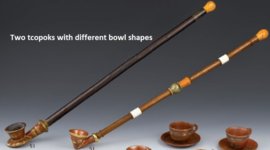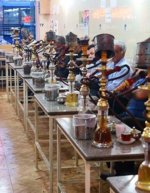I was trying to find the best information about Shiraz tobacco. I think it's a little ready now.
First of all, I always thought that Shiraz and Isfahan tobaccos are resembles each other so Shiraz may be a type of tombac which is generally used in hookahs. There’s another reference strenghten my wiev. There’s no cigarette tobacco growing areas in southwestern Iran, there is only hookah tobacco production in that regions (e.g. Isfahan, Shiraz etc.). Cigarette (or pipe) tobacco growing areas mostly exist in northwestern and northern regions of Iran.
Here are some hookah tobacco packages from Iran (produced by state monopoly of Iran "ITC")


There're four records in ARS-GRIN about tobacco of Shiraz;
1- PI 483078 - Shirazi - Donated : Iran - N. tabacum
2- PI 22167 - Shiraz (Persia) - Donated : Campania, Italy - N. tabacum
3- PI 58029 - (no name) - Iran – N. tabacum - Seeds of the finest grade of the Persian tobacco variety known as "Shiraz Tumbac" - Seeds presented through Bernard Gotlieb, American consul.
4- PI 17501 - Schiraz - Donated : Campania,Italy - N. alata
In PI 483078 (Shirazi) observations are available (Bob already wrote it another thread) but for others observations are not available in the site.
They're all (or said to be) originated from same region, Shiraz (the capital of Fars Province, Iran) but their names in the records are look different. It may be because of the seed donors’ or ARS-GRIN’s fault, because there's a language barrier between them.
For example, for the name of "Schiraz", this is the Italian way of pronounciate Shiraz. For the "Shirazi"; Shirazi means "from Shiraz" in Persian. I think you all know Shirazi wine
Three of them are N. tabacum varieties but 4th is a N. alata variety. It may be, because N. alata is native to Brazil. It's claimed that Portugese merchants and sailors intoduced tobacco to Iran in 16th century. But some references claimed that tobacco was not introduced to Asia before 1600. We’re lack of certain information. Also I'm not sure if anybody grew the N. alata variety of Shiraz.
BTW, there's a poem about tobacco (and hookah) belongs to a Shirazi poet which was died in 1536. You know Shiraz is the city of poets.
The poem is like this ;
"From your lips the waterpipe drows enjoyment
In your mouth the reed turns sweet as sugar cane
It is not tobacco smoke in your face
It is a cloud circles around the moon"
In the ARS-GRIN record PI 58029 is defined as "seeds of the finest grade of the Persian tobacco variety known as "Shiraz Tumbac". I think this is a good point too.
There's also another point is about "tombac". Iranians started to smoke with hookah (or as they say, qalyan or nargilah) and tchopok (a long pipe generally made of clay, wood or sometimes metal). Cigarette smoking and cigarette tobaccos are relatively new (compared with tombac).
I know that, tobacco produced in south-western Iran (like Shiraz and Isfahan) classified in two groups. 1st grade (tombac), 2nd grade (tchopok). Actually these two classes of tobacco can be both used in hookah but 2nd grade (tchopok) tobaccos are also used for smoking traditional pipe (tchopok).

I think the variety that some of the members have here is "Shirazi (PI 483078)" from the ARS-GRIN. I’m not sure if somebody have the other three varieties but if you have Shirazi it's worth a try in hookah (as in the form of leverhead's tömbeki) or in a pipe.
First of all, I always thought that Shiraz and Isfahan tobaccos are resembles each other so Shiraz may be a type of tombac which is generally used in hookahs. There’s another reference strenghten my wiev. There’s no cigarette tobacco growing areas in southwestern Iran, there is only hookah tobacco production in that regions (e.g. Isfahan, Shiraz etc.). Cigarette (or pipe) tobacco growing areas mostly exist in northwestern and northern regions of Iran.
Here are some hookah tobacco packages from Iran (produced by state monopoly of Iran "ITC")


There're four records in ARS-GRIN about tobacco of Shiraz;
1- PI 483078 - Shirazi - Donated : Iran - N. tabacum
2- PI 22167 - Shiraz (Persia) - Donated : Campania, Italy - N. tabacum
3- PI 58029 - (no name) - Iran – N. tabacum - Seeds of the finest grade of the Persian tobacco variety known as "Shiraz Tumbac" - Seeds presented through Bernard Gotlieb, American consul.
4- PI 17501 - Schiraz - Donated : Campania,Italy - N. alata
In PI 483078 (Shirazi) observations are available (Bob already wrote it another thread) but for others observations are not available in the site.
They're all (or said to be) originated from same region, Shiraz (the capital of Fars Province, Iran) but their names in the records are look different. It may be because of the seed donors’ or ARS-GRIN’s fault, because there's a language barrier between them.
For example, for the name of "Schiraz", this is the Italian way of pronounciate Shiraz. For the "Shirazi"; Shirazi means "from Shiraz" in Persian. I think you all know Shirazi wine
Three of them are N. tabacum varieties but 4th is a N. alata variety. It may be, because N. alata is native to Brazil. It's claimed that Portugese merchants and sailors intoduced tobacco to Iran in 16th century. But some references claimed that tobacco was not introduced to Asia before 1600. We’re lack of certain information. Also I'm not sure if anybody grew the N. alata variety of Shiraz.
BTW, there's a poem about tobacco (and hookah) belongs to a Shirazi poet which was died in 1536. You know Shiraz is the city of poets.
The poem is like this ;
"From your lips the waterpipe drows enjoyment
In your mouth the reed turns sweet as sugar cane
It is not tobacco smoke in your face
It is a cloud circles around the moon"
In the ARS-GRIN record PI 58029 is defined as "seeds of the finest grade of the Persian tobacco variety known as "Shiraz Tumbac". I think this is a good point too.
There's also another point is about "tombac". Iranians started to smoke with hookah (or as they say, qalyan or nargilah) and tchopok (a long pipe generally made of clay, wood or sometimes metal). Cigarette smoking and cigarette tobaccos are relatively new (compared with tombac).
I know that, tobacco produced in south-western Iran (like Shiraz and Isfahan) classified in two groups. 1st grade (tombac), 2nd grade (tchopok). Actually these two classes of tobacco can be both used in hookah but 2nd grade (tchopok) tobaccos are also used for smoking traditional pipe (tchopok).

I think the variety that some of the members have here is "Shirazi (PI 483078)" from the ARS-GRIN. I’m not sure if somebody have the other three varieties but if you have Shirazi it's worth a try in hookah (as in the form of leverhead's tömbeki) or in a pipe.



